Mark Sisson's Blog, page 342
April 18, 2013
How Small Wins Can Lead to Big Success
 They say it’s the little things, and maybe it is. When we think of health goals (among other objectives), our minds often gravitate toward the dramatic, the transformational. Go big or go home, some even say. While that last point might be pushing it (all positive change is positive), I tend toward the big and bold myself. I believe in the possibility of transformation (the titles of my books are obvious evidence of that). Yet, Rome wasn’t built in a day. Unfortunately, too many people get psyched out by the size of the enterprise itself. They focus on the large expanse between where they are now and where they want to be. That’s exactly where they shouldn’t be placing their attention. Success isn’t built by daily yearning for a distant goal. It’s in creating and celebrating the small wins we can plot along the way.
They say it’s the little things, and maybe it is. When we think of health goals (among other objectives), our minds often gravitate toward the dramatic, the transformational. Go big or go home, some even say. While that last point might be pushing it (all positive change is positive), I tend toward the big and bold myself. I believe in the possibility of transformation (the titles of my books are obvious evidence of that). Yet, Rome wasn’t built in a day. Unfortunately, too many people get psyched out by the size of the enterprise itself. They focus on the large expanse between where they are now and where they want to be. That’s exactly where they shouldn’t be placing their attention. Success isn’t built by daily yearning for a distant goal. It’s in creating and celebrating the small wins we can plot along the way.
Inherent to this idea of small wins lead to bigger successes is what Teresa Amabile, author and Professor at the Harvard Business School, calls the “progress principle.” Amabile and her associates studied employees’ daily diaries that her team designed. They found the efforts of tracking small achievements each day (as well as reflecting on challenges) enhanced workers’ motivation as well as creativity. The chance to consider and record one’s progress, she explains, helps us appreciate our “small wins” and boosts our sense of competence. We can then “leverage” that confidence (as well as lessons learned from the reflection) toward subsequent, larger successes. Amabile stresses there’s always some progress to recognize in a day, even on the most challenging or discouraging days.
That notion alone is pivotal. I’ve met a lot of people up against major health challenges or weight loss issues. Among the key things that got them through (while others tended to give up) was the ability to appreciate small changes and celebrate where they were throughout the arc of their progress. They brought awareness to their full journey and focused on the positive every step of the way. Sure, they had difficult days like everyone else, but they recognized a temporary mood and let it pass. They didn’t let it define the future or whole endeavor. Applying Amabile’s suggestion, we can – and should – acknowledge the small physical and mental shifts we experience regardless of how far we may be from our eventual health objectives.
Yet, too often we downplay our progress or even talk ourselves out of it for the sake of guilt, unworthiness, or misguided modesty. Why? We’re taking the wind out of our own sails instead of leveraging, as Amabile suggests, our daily successes toward continuing motivation. Charles Duhigg, author of acclaimed book The Power of Habit explains the durable impact of these small achievements: “A huge body of research has shown that small wins have enormous power, and influence disproportionate to the accomplishments of the victories themselves.” In other words, it makes no difference how minute our day’s achievement is because – when we allow ourselves to recognize the wins and leverage these “tiny advantages,” as Duhigg calls them – the power we absorb from each small win will always be more substantial than the original event. Progress takes on a life of it’s own – like motivation gone viral within our brain.
This viral principle, however, isn’t limited to the day’s post-mortem assessment. Our day’s routine in and of itself is ripe for subtle but strategic revolution. Duhigg writes about the power of “keystone habits,” those habits that, while seemingly modest and self-contained, have inordinate sway over other choices we make and actions we take throughout the day. Adopting a single new habit, if it’s of a pivotal keystone variety, can enact widespread change in our lifestyle. Among the examples Duhigg highlights is food journaling. In an NIH study of some 1600 obese people, those who were asked to write down a day’s food intake one day a week ended up losing twice the weight as other groups. The request was enough to get many of the participants to extend the habit into other days of the week and, as Duhigg explains, “created a structure that helped other habits to flourish.”
The key here is to discern what habits can become “keystone habits” for your health journey. As the principle suggests, it’s unnecessary to overload yourself with a laundry list of changes to your routine. That’s the principle behind the “keystone” approach: you don’t need to upend your life or turn yourself inside out working toward change. You just need to be strategic about what to shift. Ultimately, it’s about letting these few changes build momentum in your life and then fueling that momentum with the energy of celebrating each small win. It’s the snowball effect at its multidimensional best. The end result can be achieving that ultimate goal you set as well as successes you may have never envisioned.
Intriguing concepts, I’d say. I’d love to hear your thoughts. Next week I’ll apply them to living Primally with a sizable list of PB inspired small wins and keystone habits. For those of your just getting started in your Primal journey, I hope they’ll serve as a good jumping off point. For others further along in applying the PB, they can perhaps spur you toward tackling new dimensions or refocusing your efforts.
Thanks for reading everyone. Have a great end to the week.
Limited Time Offer: Get the Primal Essentials Kit on Autoship and Receive a FREE Copy of The Primal Blueprint 90-Day Journal

April 17, 2013
10 Psychological Hurdles Keeping You From Losing Weight (and How to Overcome Them)
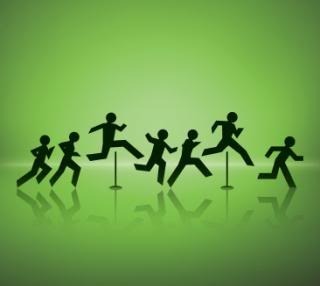
A few weeks back, I discussed nine (more) reasons you might not be losing the weight you want, and I got a lot of responses. Those were mostly “physical” reasons grounded in physiological terms we usually use to describe weight loss or gain. In other words, they were the ones you expect, things like eating too little and tanking the metabolism, suffering from “hidden stress,” disordered eating, or training too hard with inadequate nutrition. Today, I’m doing something a bit different. Instead of couching everything in the body, I’m focusing more on the ways in which our minds (which, of course, are part of the body, but we typically separate the two in common parlance) trip us up and prevent us from losing weight.
Let’s jump into it.
You’ve Developed Poor Habits
Habits become ingrained in our days and in our brains to the point where it just doesn’t feel right without them. Now, if your habits take the form of regular exercise, eating plants and animals, and getting good sleep, you’re in good shape. If your habits look a little different, you might not be:
The coffee and crueller (stat!) on the way to work. The handful of candy beans every time you pass the candy-loving receptionist’s desk. The nightly six pack. The propensity to plop down on the couch and stay there for hours after work. We’ve all got some bad habits, and depending on their composition, they can disrupt our ability to lose weight.
It’s easy to recognize our bad habits, but it’s tough to break the cycle using sheer willpower. Instead, try to understand the underlying contexts that give rise to the habits. That way, you can target the contexts – the situations, the emotions, the cues – that trigger the habit.
It could be as simple as taking a different route to the bathroom to avoid the receptionist’s candy-laden desk, or it could be as hard as examining why you feel the need to drink six beers at night.
You can also replace the bad habit with a good one. If you’re craving that morning pastry, eating a piece of sweet fruit instead might be easier than just going without altogether.
I recommend The Power of Habit for those looking to learn more about habits, how to break bad ones and create new ones.
You’re Afraid of Being a Social Pariah
We are social animals. In fact, acknowledgement and indulgence of that fact is crucial for maintaining and supporting personal health. It’s the rare person who can live without social contact with other humans and remain happy and healthy. That innate drive to be accepted by and avoid offending those around us, however, can also keep us from making the right dietary choices when those around us are constantly bringing cookies into the office, going out to eat at the Chinese buffet, ordering wings and fries at happy hour, and so on.
There’s no easy way to relish social pariahism, although I think a healthy dose of it leads to superior health (more for being independent/your own man/woman than for any dietary advantages it confers). You can’t just decide to be happy about being the weird person who turns down the birthday cake. You can, however, decide to be the weird person who turns it down. Sometimes there’s no easy way around the hurdle, no strategic path. Sometimes you just have to bull your way through it and bear the consequences. Like running hurdles on the track, scaling this particular psychological hurdle gets easier the more you do it. Turn down the cake a few times and you’ll realize that it’s not so bad after all and people really don’t care.
Just don’t make a big deal out of it when you say no. Don’t get indignant or lecture-y.
You Still Fear Fat
Years of indoctrination from mass media, your family, doctors, “experts,” and pretty much everyone can have you convinced that fat is a scary, inherently dangerous macronutrient – even if you can intellectually accept its place in the human diet. No matter how many studies you read exonerating dietary fat as the cause of heart disease and obesity and diabetes and how many success stories you hear from people who ate fat to lose fat, there may always be a voice deep down inside saying “you know that stuff will kill you, right?” Even though you know it’s not anything to worry about and a high-fat diet actually can be incredibly healthy, the animal instinct is strong and stubborn. And yet if you don’t shake that fear of fat even as you reduce your carbohydrates, you’ll end up on a low-carb, low-fat, overall low energy diet that won’t get you anywhere but stuck and stalled.
It’s tough to shake indoctrination, but it can be done. Read GCBC, at least the first half that deals with the diet-heart hypothesis to have your fear ripped asunder to be replaced with a strong yearning for butter. Read the success stories on this very site from people who ate lots of fat and lost weight, improved their blood markers, and lowered their risk of developing heart disease. Taken together, clinical research and personal anecdote combine to form a powerful de-conditioning agent.
You Eat for Comfort
Comfort eating has an initial utility, I’ll admit. If you’re stressed out and can’t handle the situation, eating something that comforts you and lowers stress can be helpful, regardless of the nutritional composition of the food in question. However, if that becomes a habit, if you find yourself eating fried chicken and waffles four nights a week in order to make yourself feel better, your weight loss will almost assuredly halt – or reverse itself altogether, leading to an entirely different kind of “feeling bad.”
The problem is the stress, not the food. If you just keep switching up the food without addressing the root cause, you’ll never truly break through. You need to figure out what’s stressing you out and then take steps to reduce or mitigate it. If that means taking specific steps, like avoiding a particularly caustic personality in your life or switching jobs at the first available opportunity, so be it. It might also require taking a more general approach to stress reduction, like daily meditation, a morning walk, or some time in nature. Better yet, take both specific and general steps.
You’re Stuck on What Worked at First Even Though It’s Not Working Anymore
The initial weight loss is a rush. It comes so quickly and so effortlessly (for many people) that people often assume that doing whatever caused that first big burst of change will work in perpetuity. They become wedded to the initial method, even as it stops working. People tend to do that – to identify strongly with a belief or a group, especially if it’s generally worked very well for them. This identification often persists even when it stops working, or stops working quite so smoothly. It’s “normal” human behavior, but it can still be counterproductive or even destructive.
Maybe early on you didn’t have to think about caloric content, but now you should consider it.
Maybe early on you didn’t have to exercise much beyond walking, but now you could really benefit from more.
Maybe early on you didn’t have to worry about anything but diet, but now you should explore the other important aspects of Primal life.
You Think “Why Even Bother?”
Stalling is hard, especially if it persists for months on end. But stalling is completely normal. Weight loss (as mentioned above) is easiest when you have the most to lose. Dropping 100 pounds off of 300 in a year isn’t too tough and happens all the time, while dropping the last twenty when you’re sitting at 200 is considerably tougher and often takes a lot longer. This can be incredibly discouraging, especially if you’re “used” to losing weight faster.
The solution? Don’t give up. Don’t throw in the towel. Focus on all the other benefits you’ve accrued. Enjoy the improved and steadier energy throughout the day. Cherish the newfound appreciation and capacity for outdoor activities. Rub your skeptical friends’ faces in your blood test results (not the actual blood, but rather the numbers). If you do these things and keep on keepin’ on, the weight loss will come. But it will never come if you give up.
You’re Embarrassed to Go to the Gym
Ah, the gym: hall of mirrors, impossibly ripped testosterbros, models, and high standards, all of whom are prepared to gaze disapprovingly in your specific direction. Or so some people assume. In reality, the gym is full of people trying to lose some weight, build some muscle, and gnash their teeth in pleasurewrath at the latest episode of Hannity on Fox as they walk the treadmill. And most of them are just as self-conscious as you.
Embarrassment is another hurdle that can’t be surmounted by tricks. You just gotta go for it. Before you know it, you’ll either be too fit and strong to worry, or you’ll have stopped caring. That said, there are a few strategies to ease your embarrassment:
Consider a trainer. A trainer will help you perform the lifts with confidence and grace so that you don’t think you look funny (even though you don’t and no one cares anyway).
Get a plan. Don’t just go in and start doing strange things with the dumbbells. Follow a legitimate program like Starting Strength (barbells), Convict Conditioning (bodyweight), Overcoming Gravity (gymnastics), or Raising the Bar (bar calisthenics). Primal Blueprint Fitness is another (free) option.
Go during off hours. You can get your workouts in relative solitude.
Work out elsewhere. Who needs the gym? Not everyone. Go for hikes, lift your own bodyweight, build a home gym, buy a few kettlebells and a sandbag and make a slosh tube or two, play sports. You don’t need the gym to work out and lose weight.
Besides, those big guys with tank tops that show ample man nipple? They’re more concerned with staring at themselves than anyone else – as should you.
You Think in Black and White/All or Nothing
A while ago, I warned you guys against making the perfect the enemy of the good: bailing out because you can’t get grass-fed/organic/pastured/wild/perfect everything. That advice still stands, especially the more wrapped up you get in all this Primal stuff, and yet I hear about it a lot.
You’ve read all about the benefits of grass-fed beef, so you won’t touch anything that ate a grain and end up unable to afford this diet.
You can’t find a farmers market near you and have no room to grow your own veggies, so rather than buy conventional produce from the supermarket, you avoid plants altogether.
You eat a bite or two of nigiri (with the rice) along with some shrimp tempura and freak out on yourself, going on a three day water fast to cleanse the impurities and end up derailing the entire ship, tanking your metabolism, and triggering a weeklong binge.
The vast majority of the millions of unique visitors Mark’s Daily Apple gets every month aren’t buying exclusively grass-fed beef and pastured chicken, shunning every green vegetable if it isn’t organic and hand delivered by the farmer, and making zero mistakes or concessions. And yet somehow they keep coming back. Somehow we keep getting success stories. Somehow people are getting massive benefits from adopting a less than perfect Primal lifestyle. Realize this, and the black and white thinking should dissipate.
You’re Depressed
Depression is often linked to weight gain, and the two appear to be mutually reinforcing. Whether you overeat because you’re depressed and want to cope with the depression or are depressed because you’re overeating, the connection between the two is undeniable.
It could be a very mechanistic thing, too. Although depression is typically imagined and conceived of as purely a psychological matter (“of the mind”), it’s also of the body. In a post from last year, Dr. Emily Deans explained how depression can lead to increased cortisol, circulating levels of inflammatory cytokines (throughout the body and the brain), impaired glucose tolerance, and accumulation of visceral fat. Resistin, a hormone that increases insulin resistance and diabetes, also increases during depression. Depression has long been linked to type 2 diabetes, too.
Unfortunately, there’s no easy fix for depression. Antidepressants may help in some situations, but even the relationships between antidepressants themselves and weight gain/loss are unclear (and vary depending on which medication you’re using and how long you’re using it). A generally healthy Primal lifestyle full of good food, smart activity, social contact, nature exposure, and all the other trappings I discuss can’t hurt, of course. Don’t let it fester or “tough it out,” whatever you do. Get help from someone who knows what they’re doing, whether they’ve got an MD after their name or not. You may not know exactly how to scale this particular hurdle yet, but at least you can identify and begin to assay it.
You’re Constantly Comparing Yourself to Others
As animals subject to competitive pressures, we have the tendency to constantly compare ourselves to other members of the species. We’re sizing each other up, trying to see what’s working and what isn’t for the other guy, either to gauge our ability to beat them in a had to head match up or to learn from their successes and failures. An animal that wonders about its own existence also has the ability to wonder about how they stack up against other animals. It’s a feature and a shortcoming all at once.
As for how this can become a psychological hurdle impeding weight loss, there can be a couple reasons. I’ve seen people rushing from dietary change to dietary change based on other people’s experiences without pausing to consider whether those modifications make sense for their situation. There’s nothing wrong with drawing on another person’s experience or advice to apply it to your own, but you have to stay abreast of the results. You have to give it a chance to work – or to not work.
There’s also the fact that when you look at someone else who’s seemingly got it all together, you’re only looking at their outward projections. If you could gain access to their inner workings, you’d likely find yourself tramping around in puddles of self doubt, self consciousness, and self criticism, just like we all deal with from day to day.
That’s what I’ve got, folks: 10 solid, but not insurmountable, hurdles. Let me know what you think in the comment section, and be sure to include any psychological hurdles I might have missed. Thanks for reading!
Grab a Copy of The Primal Connection: Follow Your Genetic Blueprint to Health and Happiness Today!

April 16, 2013
6 More Tea Ingredients That Can Help You Unwind, Relax and Chill Out
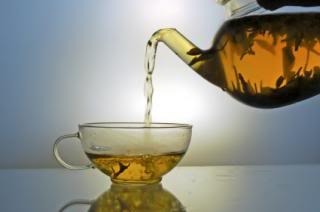 Last week, I made the case for the inclusion of chill-out, relaxing, and otherwise anti-stress teas and herbs, particularly for the stress-wracked among us (and who doesn’t deal with significant amounts of stress?). Several readers on the last post made the comment that, while effective, these tea ingredients don’t necessarily please the palate. I believe one even used “feet” to describe the flavor and aroma of valerian tea. That may be true, but I’d argue that when your sanity, your testosterone:cortisol ratio, and your mental well-being are on the line, pharmacological efficacy of a particular herb supersedes any concerns regarding its flavor. Stress kills, and, well, we want to live – and live well.
Last week, I made the case for the inclusion of chill-out, relaxing, and otherwise anti-stress teas and herbs, particularly for the stress-wracked among us (and who doesn’t deal with significant amounts of stress?). Several readers on the last post made the comment that, while effective, these tea ingredients don’t necessarily please the palate. I believe one even used “feet” to describe the flavor and aroma of valerian tea. That may be true, but I’d argue that when your sanity, your testosterone:cortisol ratio, and your mental well-being are on the line, pharmacological efficacy of a particular herb supersedes any concerns regarding its flavor. Stress kills, and, well, we want to live – and live well.
With that said, let’s look at a few more options. With any luck, you’ll find at least a couple that you can stomach and perhaps even enjoy.
Ashwagandha
What is it?
Ashwagandha, also known as Indian ginseng, is often said to be the granddaddy of Ayurvedic herbal medicines. It’s made from the roots of Withania somnifera, a member of the nightshade family, and usually comes in powder form. Roughly translated, ashwagandha means “smell of the horse” – a reference not only to its distinct odor but also to its purported health benefits (“strong like horse”).
History?
It seems ashwagandha has been used as a traditional medicine for around 4,000 years across India, Sri Lanka, and Pakistan, giving it a pretty substantial history of use.
What is it purported to do?
It’s billed as an adaptogen, or a substance that helps the body resist stress and maintain homeostasis in the face of it. By virtue of this stress-reducing effect, ashwagandha may help improve or mitigate other stress-related conditions, like insomnia, lack of libido/erection, and anxiety.
Does the research back that up?
For the most part, yes – ashwagandha appears to be the real deal.
Among adults with a history of chronic stress, 300 mg ashwagandha extract reduces cortisol and anxiety and improves resistance to additional stress. Earlier studies (PDF) have found similar results in chronically-stressed humans.
In concert with deep breathing relaxation techniques and dietary counseling, ashwagandha reduces anxiety.
In male infertility patients, ashwagandha improves semen quality and improves testosterone status by reducing the impact of oxidative stress.
Giving ashwagandha to animals exposed to stress prevents the normal rise in lipid peroxidation.
Only problem, as I see it, is the horse thing.
Is it safe?
Yes. Although high doses can cause sedation to the point of sexual impairment, the LD50 (the dose at which 50% of test subjects die) is high enough to say it has “little or no associated toxicity.”
Where to find it?
Amazon.com has several options available, including both extracts and whole root powder.
Lemon Balm
What is it?
Lemon balm is a culinary and medicinal herb from the mint family. There are several different cultivars, including “citronella” and “lemonella.” Overall, lemon balm has a bit of a lemony minty scent that lends itself well to fish dishes.
History?
The ancient Greeks and Romans employed lemon balm as a medicinal herb, and it was catalogued in the Historia Plantarum as far back as 300 BC. Homer’s The Odyssey mentions “balm,” which scholars assume refers to lemon balm. Something to keep in mind, however much you admire the classic Hellenists: Jackie Chiles is adamantly against the unprescribed application of any and all balms, including lemon balm.
What is it purported to do?
Lemon balm has historically been used to reduce anxiety and lower stress, along with the associated symptoms. It also makes a pleasant tea.
Does the research back that up?
Yes, it appears to lower the negative effects of stress, reduce anxiety, and increase overall relaxation, as these studies suggest:
When combined with valerian, lemon balm reduces lab-induced stress in human subjects. The combo also reduces restlessness in afflicted children.
Lemon balm appears to reduce cortisol concentrations and increase GABA, perhaps by inhibiting the enzyme which degrades GABA. This particular enzyme is a common target in anti-anxiety treatments.
Lemon balm alone is able to lower the negative effects of lab-induced stress, improving calmness, alertness, and cognitive performance.
Lemon balm also improves mood in healthy young humans.
Is it safe?
I saw a couple references claiming that lemon balm is a bit goitrogenic and may even reduce thyroid hormone absorption, but I wasn’t able to substantiate that with any solid studies. Overall, it’s non-toxic, although some people may get contact dermatitis from the leaves (PDF).
Where to find it?
You can get lemon balm tea, lemon balm extract, or lemon balm leaf. All are effective.
Passion Flower
What is it?
A flowering vine that appears in most countries. With over 500 species, it’s a fairly successful plant. It produces lovely flowers, tasty passion fruit, and its roots and leaves are dried and used as medicines. Today, we’re most interested in the roots and leaves – the herb.
History?
The use of passion flower as a medicinal herb seems to date back to the indigenous peoples of the Americas. Since then, it’s taken off in popularity across the world, with some varieties even possessing MAO-inhibiting properties that increase the bioactivity of certain psychoactive substances (the traditional visionary medicine ayahuasca, for example, requires a similar naturally-occurring MAO inhibitor to work).
What is it purported to do?
Since it contains myriad alkaloids, flavonoids, phenolic compounds, glycosides, and other bioactive plant compounds, it seems to do a lot. Foremost, though, is its ability to reduce anxiety and stress.
Does the research back that up?
Yes, several studies show efficacy:
Passion flower tea improved sleep quality in human subjects.
Passion flower is effective against generalized anxiety disorder, and it has fewer side effects than traditional pharmaceuticals.
In pre-surgery patients, passion flower can reduce anxiety without causing sedation.
Is it safe?
It’s generally safe, but it has been shown to interact poorly with anti-anxiety medications like Ativan. Don’t mix medicines – even herbal ones – without instruction from a professional.
Where to find it?
Passion flower tea, extract, and dried leaf are all widely available online.
Hops
What is it?
The female flowers (which kinda look like cones) of a species of hop.
History?
Hops are most famous for their role in beer brewing, where they provide stability and flavor. India pale ales, which were brewed to survive the long voyage to Asia, contained extra hops as a preservative – that’s why they’re so incredibly bitter. Hops seem to have originated in Asia, and medieval Germany was the site of the first European cultivation.
What is it purported to do?
It’s said to be a mild sleep aid, especially when combined with valerian.
Does the research back that up?
There are a few studies that support the claims:
Together with valerian, a single dose of hops is effective at improving sleep quality, perhaps by opposing caffeine’s antagonistic effect on adenosine.
Hops in the form of non-alcoholic beer improves sleep quality in work-stressed nurses.
Hops increases sedation, which improves sleep.
Is it safe?
Hops themselves are safe, but drinking a twelve pack just “to get your hops in” might cause some health issues.
Where to find it?
You could drink beer (either alcoholic or non-alcoholic), particularly pale ales (or India pale ales), which contain the most hops, but also plenty of grain. Or, you could go for a hops extract or a hops tea.
Holy Basil
What is it?
Also known as tulsi, holy basil is another cherished Ayurvedic herb. It grows all over the eastern tropics as both a cultivated and wild plant.
History?
Ancient Hindu and Ayurvedic texts speak highly of holy basil. Thai restaurants (good, traditional ones) frequently employ it in their cooking.
What is it purported to do?
In Ayurvedic traditions, it’s said to promote general health, well-being, and longevity, but most modern usage is predicated on its supposed adaptogenic effects.
Does the research back that up?
What little evidence exists seems to:
Holy basil is effective in patients with generalized anxiety disorder, reducing the disorder itself as well as the concomitant stress and depression.
Extracts of holy basil have been shown to reduce cortisol, lower adrenal gland hypertrophy, and normalize stress-induced hyperglycemia in rodents.
Human research is very preliminary (bordering on non-existent), but Ayurvedic herbs seem to do pretty well once the studies are actually conducted. I wouldn’t be surprised if this turned out to be a strong adaptogen and ally in the fight against stress. For what it’s worth, it seems to be hepato-protective, too.
Is it safe?
The LD50 of the oil extract is 42.5 mL/kg.
Where to find it?
Amazon has holy basil tea, extracts, and dried leaves. My favorite way is to go eat some great Thai food, however. Look around for pad krapow moo – holy basil stir-fried pork. Bring a jar of coconut oil and they’ll probably even cook with it.
Siberian Ginseng
What is it?
It’s actually not a type of ginseng. Instead, it comes from a woody shrub that grows in Northeastern Asia (including, obviously, Siberia).
History?
Traditional Chinese medicine has used it for many centuries.
What is it purported to do?
While not a sedative by any means, Siberian ginseng apparently improves one’s resistance to stress and reduces the stress response. This can have an “energizing” effect, if stress is beating you down or causing fatigue (like in overtraining).
Does the research back that up?
For the most part, yes:
Extracts of Siberian ginseng reduce the normal cortisol elevation and immune dysfunction triggered by lab-induced stress.
Siberian ginseng induces vaso-relaxation, thereby attenuating the stress-related increase in blood pressure.
For over-stressed runners with fatigue, Siberian ginseng improves endurance performance and capacity.
So, while Siberian ginseng isn’t going to sedate or necessarily chill you out, it will help you adapt to and resist the negative effects of stress – which do often manifest as anxiety or excitability. I know when I’m stressed out, I’m often wired.
Is it safe?
The LD50 is around 3 g/kg of the extract or 25 g/kg of the dry root (PDF). In other words, it’s quite safe.
Where to find it?
Siberian ginseng capsules work quite well, as does the bulk tea.
That’s it for this time, guys. I hope you’re able to stomach enough of these and other stress-reducing herbs to obtain all the benefits. Thanks for reading and be sure to let me know if I forgot anything!
Grab a copy of Primal Blueprint Quick & Easy Meals for over 100 Primal Recipes You Can Prepare in 30 Minutes or Less

April 15, 2013
Insider Recap: PrimalCon Oxnard 2013
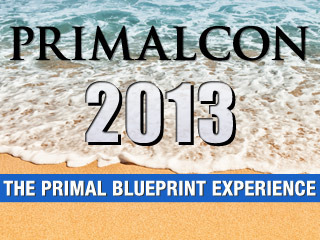 In case you missed it, PrimalCon Oxnard 2013 took place this last weekend. This recap of the festivities was written by Mark’s Daily Apple team member and PrimalCon attendee Erik Cisler.
In case you missed it, PrimalCon Oxnard 2013 took place this last weekend. This recap of the festivities was written by Mark’s Daily Apple team member and PrimalCon attendee Erik Cisler.
It was supposed to be sunny all weekend. That’s what weather.com kept telling us in the days leading up to PrimalCon Oxnard 2013. Sure, it was windy and kinda cold, but we were confident things would clear up. And then Friday morning, the attendees huddled together to hear Mark give the opening address of the weekend under a grey sky. “Don’t worry, guys. The sun will come.” Technically, it did. Right after lunch, it popped out and the grey dematerialized. It wasn’t exactly warm, but at least we had sun.
That was the last we saw of it all weekend. It hovered around 60 ºF, with that gray north-of-The-Wall (ASOIAF, anyone?) sameness perpetually overhead. But you know what? It didn’t even matter in the end. Because PrimalCon attendees are the hardiest bunch of customers you could ever assemble. They still ocean plunged. They still went barefoot. They didn’t complain for a second. Instead, people talked, laughed, ate, did everything but worry about circumstances out of their (and our) control. Everyone rolled with the punches (because there’s no other way to live).
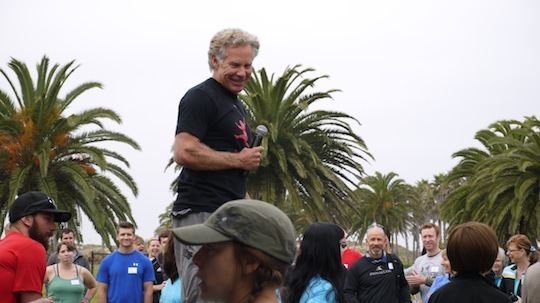

Cold weather during the day? PrimalConners just made sure to move around a bit more to get the blood pumping; natural movement, sledgehammer, Olympic lifting, and kettlebell sessions were especially popular.
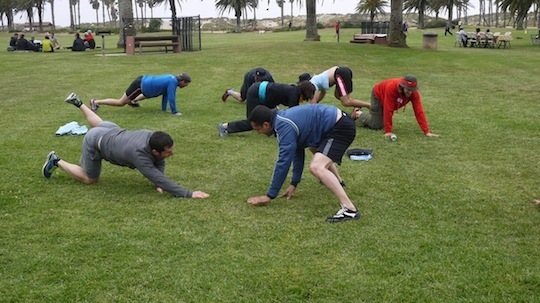
Chilly evenings? We busted out a few cases of wine (purely for the vasodilatory effect, of course) and passed out dark chocolate with ribbons of coconut manna (for the pro-metabolic lauric acid, of course).
It’s hard to put into words exactly what this weekend meant for attendees, and I knew I couldn’t do that (I’m not even going to try) so I just took little five minute snap shot observations from time to time. Here’s one: A talented doctoral student named Bryan Barksdale waxes noetic about ketone bodies and neurodegeneration to rapt audiences atop a grassy hill not fifty yards from Glen Cordoza, author/MMA fighter, showing the proper way to use a kettlebell to peel apart gnarly hip flexors right next to CrossFit champion Jenny Labaw (on crutches) showing people hip drive in the Olympic lifts while Barefoot Ted zips around on a personal laptop vehicle that will change the face of human transportation just as Angelo dela Cruz teaches untrained folks to give themselves effective healing targeted massages and right around the time top CA strongman Brian Tabor carries a guy twice his size like a sack of (gluten-free) grain, then shows others how to do the same, while Tracy Barksdale comes back from a fever to lead a group in natural movement, and across the grass Monisha and Maya White instruct attendees in the Gokhale Method of sitting/standing/lying/living. Meanwhile, the whirr of Timothy’s sledgehammers and the whip of Olympic bars and the lilt of KStar slang combine with the twang of someone else falling off the slackline laid on top of William Vives‘ GS style smooth effortless KB swings.
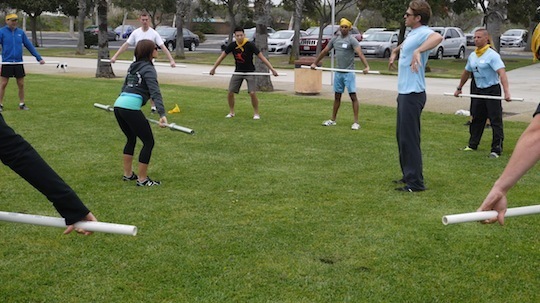
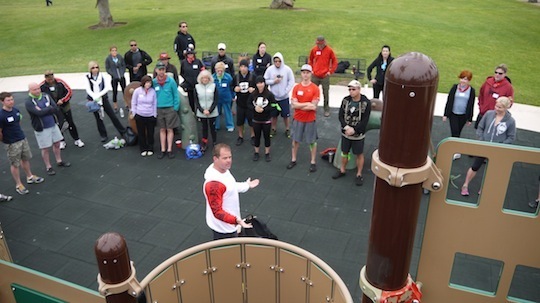
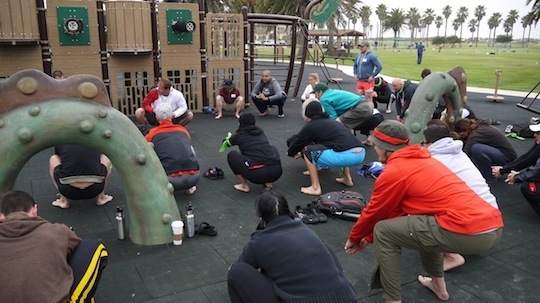
PrimalCon Attendees Attempting to Walk on a Slackline
If this all sounds a little confusing, that’s okay and I apologize, because you’d kinda have to be there to really get it. The PrimalCon energy, the vibe, cannot be transmitted through text – or even images and video – alone. You just have to be there to feel it for yourself. In the past, I feel like the reviews were easier to write. I could talk about the presenters and their talks and you’d get a good feel for what went down. This year, though, the energy was different. Better, I’d say, too. Lightbulbs were going off all over the place, groups were breaking off for impromptu sessions that weren’t ordained by some paper schedule. We had the schedule, but we also had freedom. It was a big sandbox, except instead of kids there were adults, instead of sand there was grass, and instead of sandcastles there were revelations being discovered and tribes being created.
Event Coordinator Brad Kearns “Lifting” Weights
Before my eyes, I saw people embodying precisely what Mark has been yammering about for years on this blog and in his books. They were present, they were being here/there now/then, rather than attaching their happiness to an outcome that couldn’t be. Paleosphere superstars freely mingled with blog commenters on equal footing, each learning something from the other. A tribe had formed, Dunbar’s number realized. Phones came out to take photos and immortalize moments, but I didn’t see heads buried in texts and Facebook and hashtags. No, this was real raw rendering of humanity.
It was The Primal Connection come to life. I began to wonder: were they just taking Mark’s writing to heart, or had Mark learned from watching them and put lessons to paper? Whatever – it was amazing to see.
PrimalCon: the only place where barefooters worry about shards of macadamia nut underfoot rather than glass, where you can share a dram of scotch with a ninja, a strongman, a barefoot apprentice, and a gym owner, where you get weird looks for not eating spoonfuls of coconut oil, where grandmas wield sledgehammers, where not one but a dozen experts on human movement and posture congregate, where Chef Rachel gives demonstrations and delicious samples that are never quite enough, where the first Primal food truck in Southern California caters your lunches, where teams of men and women compete for prizes by securing their feet to 2X4s with handkerchiefs and scooting along the grass three to a plank, where lifelong friendships form in a single night, where the same man who just attempted a deadlift PR gently plucks a harp’s strings not thirty minutes later, where an attendee can have earnest conversations with the best and the brightest this community has to offer – without even talking to any of the presenters yet. It’s weird and crazy and informative and awesome. In other words, it’s completely and utterly Primal.
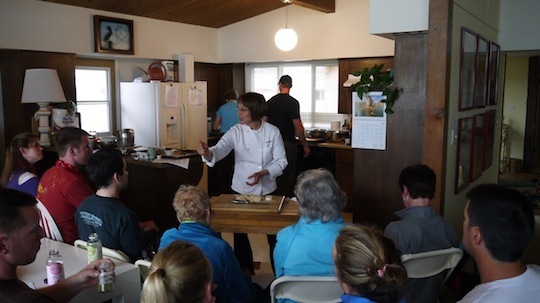
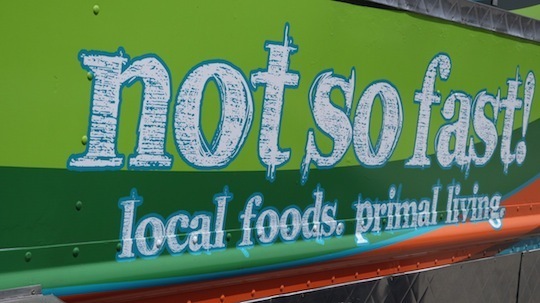
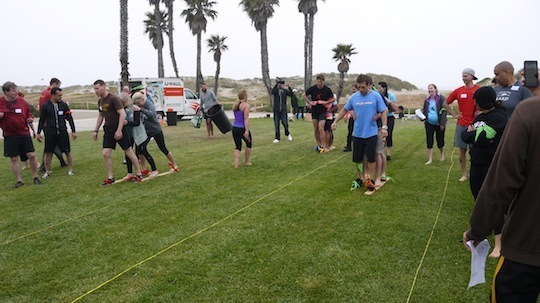

Even though I had to observe and take notes and take photos and tend to my 8-months-pregnant wife and always kinda chilled on the periphery – I had a blast. I can only imagine what the actual attendees got to experience (but I think the smiles and laughs were a pretty good hint)!
Until Austin, and then Tahoe, and wherever else we decide to take this show. Hope to see you all there!
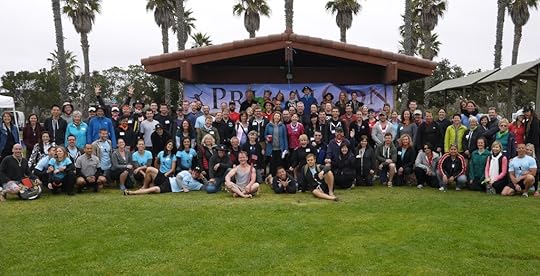
click to enlarge
Order Your Ticket to PrimalCon Austin 2013 Today and Join Other Primal Enthusiasts this Coming June for a Weekend You’ll Never Forget

April 14, 2013
Weekend Link Love
 Rich Food, Poor Food has hit select Costcos! To commemorate it – and to let Costco know it would behoove them to carry it everywhere - we’re putting on a raffle. Buy a copy from Costco (or any other online or brick-and-mortar store), send in your receipt, and be entered to win some cool prizes.
Rich Food, Poor Food has hit select Costcos! To commemorate it – and to let Costco know it would behoove them to carry it everywhere - we’re putting on a raffle. Buy a copy from Costco (or any other online or brick-and-mortar store), send in your receipt, and be entered to win some cool prizes.
Research of the Week
The connection between obesity and altitude.
Want the blood pressure, diabetes, heart disease, and blood lipid-related benefits of “cardio” without, well, the tedium and downsides of running? Walking works just as well.
It seems chimps are skilled botanists.
Interesting Blog Posts
KStar shows you how to properly organize, brace, and then load the spine.
A former vegan explains how veganism caused her and her family’s health issues, and why she feels (and looks) much better with high-quality animal foods in her diet and grains, legumes, and seed oils out of it.
Media, Schmedia
Are we too reliant on prescription meds? Have we become a pill nation?
Chris Masterjohn, Chris Kresser, and Paul Jaminet also commented on the red meat study.
Everything Else
Pro basketball player goes Primal, uses MDA as a transition tool, has lovely ancestral health blogger wife to document it all.
If this is the type of prescription doctors gave their patients in the 19th century, it’s no wonder the Victorians lived so long and so healthily.
Cats are even getting in on paleo these days.
Recipe Corner
Not even God could say no to these bacon deviled eggs.
Who doesn’t want to know how to make perfect carnitas?
Time Capsule
One year ago (Apr 14 – Apr 20)
5 Common Nutrient Deficiencies (and What to Do About Them) – Even Primal eaters can miss some key nutrients. Here’s how to avoid making that mistake.
Should You Chew Your Kid’s Food? – Find out if this makes sense for people who aren’t just trying to lampoon hippie parents.
Comment of the Week
“I read that APOE4 is the “ancestral” allele for the APOE genes. It is the risk factor for Alzheimer’s. I find it hard to believe that checking out mentally is in any way desirable”
I try to mentally check out at least once a day!
- Agreed. Checking out mentally for a bit, on a daily basis actually almost made the Ten Primal Laws.
Get All Three Primal Cookbooks, an Apron and More in The Primal Blueprint Chef Kit Today!

April 13, 2013
10 Tips for Making the Best Coconut Butter Ever
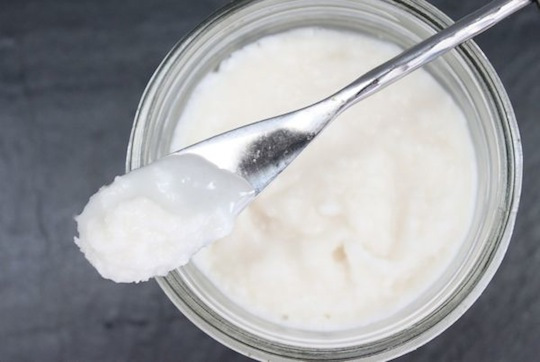
Servings: 1 to 2 cups
Time in the Kitchen: 10 to 20 minutes
You don’t need a recipe for coconut butter. After all, coconut butter only contains one ingredient: coconut. And to make coconut butter, you only do one thing: blend. What you do need, are these 10 no-fail tips for making the best coconut butter ever.
Tip #1: Buy unsweetened, dried coconut, either shredded or flakes. The flakes often turn into a smoother butter than shredded coconut does. Do not use desiccated, sweetened, reduced fat or fresh coconut.
Tip #2: Both a food processor and a high-powdered blender (like a Vitamix) can make coconut butter.
Pros of using a food processor: It’s easier to make smaller batches in a food processor and you don’t have to scrape the sides down much. It’s also easier to scrape the finished butter out.
Cons of using a food processor: Takes longer and sometimes the butter isn’t quite as smooth.
Pros of using a high-powered blender: Takes a shorter amount of time and can result in a smoother butter. You can make larger batches, but should add the coconut flakes a few cups at a time as you blend.
Cons of using a high-powered blender: You have to scrape down the sides/push the flakes down more often. Some blenders get really hot and burn out if too much coconut is added at once. It’s harder to remove the finished butter.
Tip #3: Put at least 4 cups (or 7 ounces/200g) of coconut flakes/shreds into your food processor/blender. Less than that and it’s hard to get the right consistency. This will make between 1 to 2 cups of butter.

Tip #4: Be patient. The coconut needs to be blended for 15 to 20 minutes in a food processor and half that amount of time or even less in a blender.
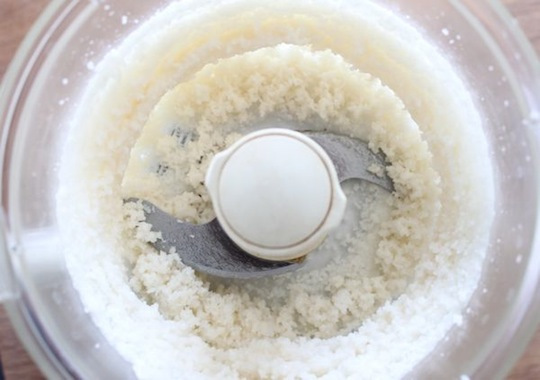
Tip #5: Stop and scrape down the sides of the machine as needed if the blade isn’t catching and blending the coconut.
Tip #6: The coconut will go through three stages on its way to turning into butter. First the texture will be finely shredded, then thin out into a grainy liquid, then finally turn into a smooth, thick liquid. The finished butter will seem runny, but when you taste it the texture will be like thick, sticky, slightly grainy peanut butter.
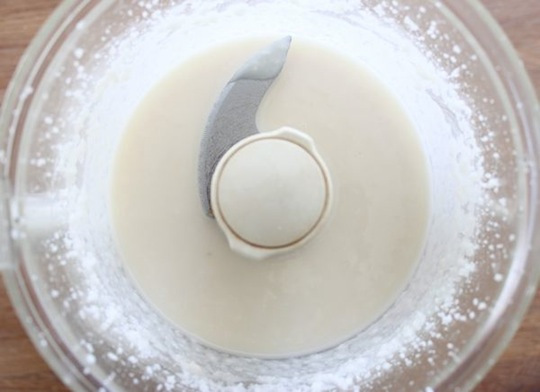

Tip #7: Pour the butter into a glass jar and let it cool to room temperature so it has a solid but spreadable consistency.
Tip #8: Cover the jar with a lid and store at room temperature. There is no need to refrigerate coconut butter.
Tip #9: Warming the coconut butter up just slightly (10 seconds in the microwave) makes the texture smoother and softer.
Tip #10: Enjoy the flavor and health benefits of coconut butter in a million different ways. Eat it with a spoon or blend it into coffee and smoothies. Add it to curries. Mash it into roasted vegetables. Spread onto pancakes. Dip dark chocolate into coconut butter for dessert. Combine it with almond butter. Flavor it with sea salt, cinnamon or vanilla.
One taste and you’ll immediately realize that its incredibly rich texture and intense flavor sets coconut butter apart from other forms of coconut. If you love coconut, watch out. This stuff’s addictive.
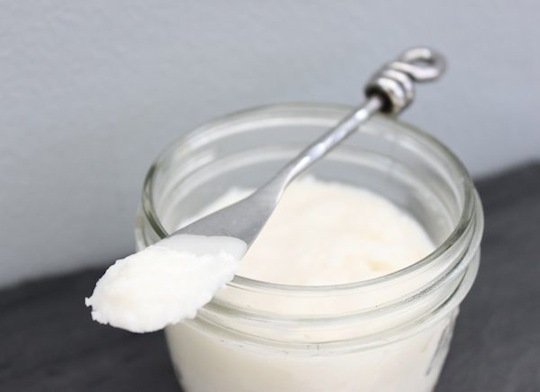
Not Sure What to Eat? Get the Primal Blueprint Meal Plan for Shopping Lists and Recipes Delivered Directly to Your Inbox Each Week

April 12, 2013
I Cannot Believe the Way My Body Has Changed
It’s Friday, everyone! And that means another Primal Blueprint Real Life Story from a Mark’s Daily Apple reader. If you have your own success story and would like to share it with me and the Mark’s Daily Apple community please contact me here. I’ll continue to publish these each Friday as long as they keep coming in. Thank you for reading!
 Today’s is a special edition of Primal Blueprint Real Life Stories. Last year, I put out a call for people to make a public commitment to going Primal in 2012. Over 500 Mark’s Daily Apple readers joined the “Success Story in the Making” challenge, submitting their personal goals, before photos, and updates throughout the year. At the beginning of this year, I reached out to the participants to see how they were doing, and the results were impressive. While it’s an ongoing journey for many of them (all of us!), the stories were familiar: weight lost, energy gained, illness overcome. Some of the participants were gracious enough to share their stories for an eBook I’ve put together. You can get it for free as a newsletter subscriber (see the details below). The following story from 26 year old Ganeesha is one of the inspiring stories included in the eBook.
Today’s is a special edition of Primal Blueprint Real Life Stories. Last year, I put out a call for people to make a public commitment to going Primal in 2012. Over 500 Mark’s Daily Apple readers joined the “Success Story in the Making” challenge, submitting their personal goals, before photos, and updates throughout the year. At the beginning of this year, I reached out to the participants to see how they were doing, and the results were impressive. While it’s an ongoing journey for many of them (all of us!), the stories were familiar: weight lost, energy gained, illness overcome. Some of the participants were gracious enough to share their stories for an eBook I’ve put together. You can get it for free as a newsletter subscriber (see the details below). The following story from 26 year old Ganeesha is one of the inspiring stories included in the eBook.
First Submission – January 7, 2012
I’m Ganeesha. I’m 26. I’m Trinidadian. I’m a primary school teacher.
My goal for 2012 is twofold. First, I intend to kick my asthma’s ass. Second, I want to do it while getting back to the size I was most comfortable at.
And I want to do it while keeping butter, bacon and play in my life.
I look forward to Groking Out for the rest of my life 
This first pic is what I looked like for all of 2011. I was 190 lbs.

I went Primal at the end of November, but could not say no to corn until January 1st. I’ve lost 15 lbs so far. I’m 175 lbs right now.
This second pic is a picture of me 5 years ago, strutting (or at least not wobbling) my stuff down a runway in Barbados. I was 145 lbs. That’s what I want to be again.

Second Submission – April 5, 2012
I cannot believe the way my body has changed. Before I went fully Primal, I had lost about 15 pounds. Since January however, I have lost a further 25.
I’ve lost 40 lbs. And I feel freakin AWESOME.

Asthma’s ass has been successfully kicked. Asthma was the symptom, not the problem. The problem was gluten. Turns out, I’m allergic. :-s
I joined a gym. I go to spin once a week, twice if I’m being extra hyper. I do a bit of weight training as well. And most notably, I did my first ever push up. Laugh all u want, I’m proud.  Since I joined the gym, my weight loss slowed down, but my fat loss continued. I’m still losing inches and I have teeny baby muscles starting to form. God, It feels good.
Since I joined the gym, my weight loss slowed down, but my fat loss continued. I’m still losing inches and I have teeny baby muscles starting to form. God, It feels good.
I won’t, I CAN’T go back. My skin has cleared up, I have all my energy back, I can breathe normally, even my work performance has improved.
My family is catching on too. I’ve put them all on to MDA. They’re still trying to wrap their minds around “No grains? EVER?” (We’re big on pasta and rice). But they’re making the effort to improve their health and they’ll get there. Eventually. I hope. Maybe my whole generation will escape diabetes. *crosses fingers*
I cannot thank all of you at MDA enough. I’m beside myself. I’m happier than I have been in years. And it’s because I found this. Thank you.
Ganeesha
P.S. Now that I’ve gotten this far, I’m going to spend the next 90 days trying to convince myself that “moderation” also applies to cheesecake and dark chocolate.
Third Submission – July 7, 2012
In my own case, My weight has stabilized at around 150 lbs. Since April however, I’ve lost some more inches. My waist, for example, has gone from 30″ to 28″. This time last year 28″ was the circumference of one of my thighs.
Next year, for the first time, I will be putting on a costume and playing mas for Trinidad carnival. I’ve wanted to for years. Now, I can. I’ll look fantastic, but more importantly, I’ll have the stamina to dance in the street for 2 days straight. 
I’m not as disciplined as I would like to be with exercising, but I go to spin class, or dive in a pool once or twice a week.
I just feel so good about everything; I feel healthy, energetic, and so freaking HAPPY all the time, that I want to practically evangelize from the rooftops about Primal Living.
And it’s contagious.
I have my own little tribe of cavemen. It’s about 10 of us (friends and family) who follow Primal Blueprint now. The results are astounding. My uncle has lost 25 lbs. My best friend has lost 30. My cousin’s weight has remained the same but his muscles are ripping out! We’re a sexy little Primal Tribe!
It’s awesome. I’m always so inspired by the stories I see on MDA, and I’ve gotten to pass that inspiration on to others. I kind of feel like a Superhero!

Thank you, thank you, thank you.
eBook Submission – March 18, 2013
What were your goals in 2012?
I just wanted to feel like I owned my body again. I wanted to be able to lead my class by example during PE and run around with them. I didn’t want to end up in the hospital wheezing anymore.
Why did you decide to go Primal, and what exactly was your plan to accomplish your goals in 2012?
After “asthma” attacks landed me in the hospital 5 times in 2011, I’d had enough. I knew something was wrong so I saw a doctor. My blood tests showed that at 26 I was pre-diabetic and pre-hypertensive. At 190 lbs, I was borderline obese. I was told that if I didn’t change my habits I would have diabetes, hypertension and heart problems before I hit 40. (All 3 run in my family.) I was instructed to give up gluten immediately (since it was an allergy to this, and not asthma, which was causing my breathing issues), along with meat, dairy, coffee, and everything else I loved. I politely refused to ever give up meat in favour of flavoured soya chunks and sought out a plan that better suited my palate. I stumbled upon a blog entry that began, “What do you feed a lion?” Grok stole my heart… And stomach.
How successful were you in sticking with your plan?
Apart from the occasional cheesecake slice or scoop of chocolate-caramel-pralines ice cream, I’ve had no problem sticking with my primal plan. At first, I can’t lie, tears were shed over the loss of bread. After about a week though, I stopped noticing the smell. Through a happy accident involving dried fruit in the spice cupboard, I now crave raisins every time I smell Cinnabon. I’ve lost 50 pounds so far, going from 190 to 140. I’m still working on my 6 pack, but my legs are amazing! Who knew this body was hiding under there all this time!


What were your biggest hurdles, and how did you overcome them?
Honestly? My biggest hurdle wasn’t dietary. I had no problems adjusting to caveman food (apart from the aforementioned bread tears). It was getting off my ass. I had to really kick my own behind to start spin class. I started walking everywhere. I lived at the top of a hill for a while, so I made it my business to walk it every day. When I moved, I started doing sprints once a week. I currently do my own version of Shaun T’s Insanity (in my version, I only do it 3 times a week and almost never go past 30 minutes. I’m not trying to pass out on the floor or cry after a workout here.)
What was your biggest accomplishment?
I feel like a Primal Evangelist. My whole life has become so much more organised since I went primal. I graduated from university, I’m more effective as a teacher (I’m as energetic as my 11 year olds!), I’m taking better care of myself and it shows… and it spreads. Several of my friends and family members are now Primal as well (my best friend, Saidi, lost 50 pounds too!), and we have our own little tribe, swapping recipes, stories and inspiration all over the place! It really is fantastic.
What did your average daily meal plan consist of?
On mornings, I have coffee with a pinch of sugar. If I have breakfast, it’s usually a layered omelette (egg, bacon, cheese, random vegetable, another egg on top). Lunch is more often than not a big salad with lamb, chicken or fish. Dinner is usually a bunch of vegetables tossed in a pot with whatever seasonings I feel like (but always including cayenne and cumin) and whatever meat is closest at hand. When I feel like dessert, there’s always fruit available and when I’m celebrating, I have cheesecake. Because sometimes I want to indulge, dammit.
What did your average weekly exercise routine consist of?
Sometimes, it’s Capture the Flag. Sometimes, Cops and Robbers. Sometimes, I swim, or run, or just walk around my neighbourhood for a while. As mentioned before, I do pseudo-Insanity 3 times a week and sprints once a week. After that, it’s all play and leisure.
What else did you change in 2012 (sleep, sun, stress management,etc.)?
Since going Primal, things sort of fell into place. I became less stressed. I sleep better. I read more. I have a constant level of energy that wanes around 10 pm and I just go to sleep. I hardly ever watch tv now. I go to the beach after work sometimes (and almost every weekend) and just relax. My body’s happier than it’s ever been and I think because of that, my mind is at ease. I just enjoy life now.
What are your goals for 2013 and beyond?
I’m happy with my life exactly the way it is. I just want to maintain that. I’m compelled to keep moving and keep healthy. I do want to organise some Primal Island recipes, that is, adapt some Primal recipes to a Caribbean ingredient list. I keep telling people about the Primal life and hopefully I can convince even more that this is the way we were meant to be. We don’t have to be shaped by our family history. We can change our own lives, bodies and destinies through our choices.
Is there anything else you would like to share?
I’m a primary school teacher. My class used to get excited about pizza. Now they scoff at it and encourage their parents to make them salads for lunch. They swap ideas and recipes for that and bring fruits, nuts and veggies to school as snacks. Not all the time, but hey, it’s a start.
Success Stories in the Making eBook
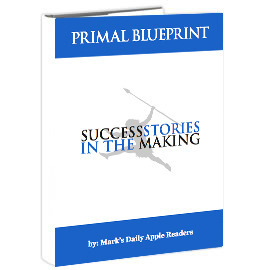 In this free eBook, dozens of Mark’s Daily Apple readers provide insights into how they took control of their health. Learn about their personal struggles, and what they did to overcome them. Find out what what they ate, how they exercised, what worked and what didn’t in their personal health journeys in 2012.
In this free eBook, dozens of Mark’s Daily Apple readers provide insights into how they took control of their health. Learn about their personal struggles, and what they did to overcome them. Find out what what they ate, how they exercised, what worked and what didn’t in their personal health journeys in 2012.
If you are an existing newsletter subscriber, click the “Free eBooks” link in the sidebar of any past email newsletter to gain access to the eBook. Or wait until the next newsletter is sent out this coming Wednesday.
If you aren’t yet a newsletter subscriber, what are you waiting for? Sign up here to get this eBook and numerous other freebies and special offers. Grok on!
Subscribe to the Mark’s Daily Apple Newsletter and Get the Success Story in the Making eBook for Free

April 11, 2013
3 Types of Fear That May Be Keeping You from Getting Fit (and How to Overcome Them)
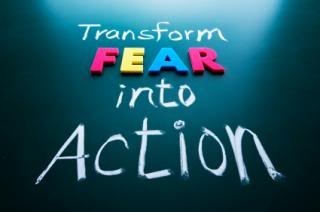 This is a guest post from Tracy Barksdale co-founder of True Nature Training and presenter at the inaugural PrimalCon Austin.
This is a guest post from Tracy Barksdale co-founder of True Nature Training and presenter at the inaugural PrimalCon Austin.
We face fear daily. Maybe you’re afraid to ask your boss for that pay raise, or maybe you’re making a big life decision. But a not so obvious way fear may be creeping into your life to sabotage your efforts for a healthier lifestyle is in your movement. Whether you’re wanting to begin a new fitness routine or are a seasoned mover, it’s worth your time to evaluate how fear could be preventing you from reaching your full potential. Confronting that fear can help you reach your goals and bring you to the next level of your training. Let’s look at some common fears that could be preventing you from getting and staying active.
Fear of Failure
Remember when you were a kid, and you felt invincible? You would try almost anything, and if you failed, you would bounce back up without blinking twice. Somewhere along the way, most of us lost a great deal of that resilience and have become scared to move!
What if we fail at something we thought we would be able to do? Failure has a bad reputation. Everyone fails, yet we are all afraid of it.
Does this inner dialogue sound familiar to anyone?
“I should really be able to do a push up…I know I used to do lots of push ups, but now I don’t think I can do any. I don’t want to fail, so I don’t want to try. I’d rather do something else.”
This is a thought process called self-handicapping. I have to admit, this one gets me. I practice Parkour and natural movement which both contain some scary skills. When I am placed in a situation where I am surrounded by practitioners who are much more experienced than I am, my first reaction is to go into self-preservation mode, so I can avoid revealing that I may not be able to do something. Since becoming aware of this behavior pattern, I can more easily recognize when I am doing it, confront it, drop the ego, and try! It is amazing how much you can accomplish when you get out of your own way.
Take Action: The key here is letting go of the ego, and developing a playful and positive attitude. Robert Allen reminds us that “There is no failure. Only feedback.” So feedback, then, will always be a part of everyone’s life in some way. You have to choose to accept this feedback as a part of the human condition. You have to start somewhere. Wherever you are, it’s okay. Take charge of your path of improvement. When you do this, you will surprise yourself with how much room for success you create.
Fear of Judgement
Let’s be honest. To some of the general population, some of the primal movements can seem strange and even child-like. (Little do they know, kids have had it right the whole time!) Climbing a tree, or rolling in the grass can be viewed as activities for kids, and adults should act like adults, not kids. I suppose that means contained in their cubicles, and not free in trees. But what is more natural than crawling in some grass, lifting logs and jumping on rocks?
Whether we are conscious of it or not, we all seek acceptance from our communities. It’s common to fear rejection from your peers if you are doing something outside of the box, and outside of the general population’s scope of what working out should look like.
Take Action: A remedy for this fear is working out/playing with a group of people. Starting a MeetUp group is an excellent way to find others interested in joining in on some primal playouts. Schedule group hikes, bring in local primal fitness experts, or get together a game of Ultimate Frisbee with your group. You might draw more attention with a larger group, but now you have the validation of an entire group of people with you. You also develop a stronger community, which in turn helps spread the word of living a Primal lifestyle. People may judge, but in the grand scope of things, you are working towards lifelong health and that trumps any judgment others may have.
Fear of Injury
Sometimes a movement can literally just be scary. The fear of going for that tall box jump, balancing high off the ground, or going for that huge lift can be a scary experience. No one wants injury, and when going into unknown territory, well…the outcome is unknown. To quote Daniel Ilabaca: “If you’re afraid to fall, you fall because you’re afraid.” If you approach a task with fear, you are preparing to fall instead of preparing to succeed. Expectations are extremely powerful. Predicting that you are going to drop the weight makes you much more likely to make that come true.
Avoid creating self-fulfilling prophecies by becoming mindful. Meditate regularly, and when you are preparing to try something new, take some deep breaths, imagine yourself succeeding, and stay focused. This mindfulness can greatly help you avoid injury.
Take Action: Progress skills properly. For example, precision jumps can be scary, yet when progressed correctly, are a great skill to practice. Begin by grabbing a couple of 2x4s and set them parallel to each other with only a foot or two distance. Practice jumping between the two and landing on the balls of your feet and absorbing through your legs to make a quiet landing. As you get comfortable with the distance, you can increase the distance between the 2×4’s. As the distance to your landing increases, the more important it is to have a parabolic jump. This means your jump’s path through the air should be rainbow shaped versus too horizontal. Not having this parabolic motion can cause an unstable landing surface to slip beneath your feet.
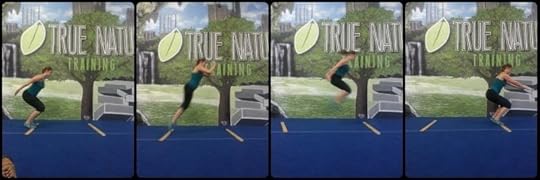
Another way to prevent injury is to have an exit strategy. What happens if mid-jump you discover you aren’t going to make it? How are you going to land? How far will you fall? How will you stop your momentum safely? Try your exit strategy before going for the actual skill. Then when you really go for it, you know how to bail out of it if you aren’t quite there yet. Practicing this exit strategy will take away some of that fear of injury.
The Take-Away
The good news is that the more often you face your fears, the better you will become at recognizing when fear is present, and knowing how to breeze past it. Starting is always the hardest part, and seeking help from those in your community is an excellent way to start. If you are looking for a place to start, you can look towards MeetUp groups, or even come join us for PrimalCon Austin this June to meet a group of welcoming and trusting people to kick start your Primal lifestyle efforts again! You will meet so many interesting presenters and attendees you will leave feeling energized and motivated to face your fears and find freedom of movement again. I will be there, and hope to see you there!
Order Your Ticket to PrimalCon Austin 2013 Today and Join Other Primal Enthusiasts this Coming June for a Weekend You’ll Never Forget

April 10, 2013
Does Red Meat Clog Your Arteries After All?
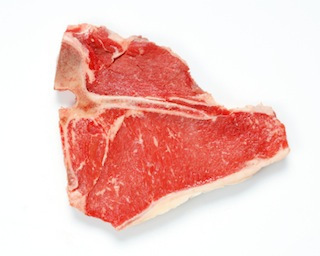 I’ve been asked to comment on the latest media deluge to suggest that red meat is again the primary cause of atherosclerosis, heart disease, and your impending doom. At least this time they’re targeting something other than cholesterol: this time it’s carnitine.
I’ve been asked to comment on the latest media deluge to suggest that red meat is again the primary cause of atherosclerosis, heart disease, and your impending doom. At least this time they’re targeting something other than cholesterol: this time it’s carnitine.
Carnitine is found in red meat, mostly, as well as dairy, tempeh, and some other meats, and it performs a number of important roles in the human body, foremost of which is the transportation of fatty acids into the mitochondria for breakdown into useable energy. It’s so important to basic function that we make endogenous carnitine by synthesizing it from the amino acids lysine and methionine. Vegans and vegetarians, who tend to run deficient in carnitine, benefit greatly from supplementation (or a nice steak). It’s even been used to reduce atherosclerosis (albeit in rabbits), improve arterial function, and help heart failure patients recover. Carnitine is not some evil compound.
Oh, the study. Let’s get into it. It consisted of several sections, actually.
First, they fed humans eight ounce steaks (amounting to roughly 180 mg carnitine) with a side of 250 mg carnitine tabs. Omnivores showed increased blood and urine levels of Trimethylamine oxide (TMAO), a compound associated with cardiovascular disease, while vegetarians and vegans (who were somehow able to get the steak down) showed far lower levels of TMAO in their blood and urine.
Next, they tested what was producing the TMAO by administering antibiotics. Eliminating gut flora populations with antibiotics also eliminated the food-induced increase in TMAO, showing that the intestinal microbiota were metabolizing carnitine into TMAO. After allowing the subjects’ guts to repopulate, they ate more steak. The increase in TMAO after eating steak reappeared, confirming that gut flora metabolism of carnitine was responsible. Subjects with higher levels of Prevotella bacteria in their guts saw the biggest increases in TMAO.
(As it turns out, gut flora convert carnitine to TMA, which the liver then converts to TMAO using a hepatic enzyme called FMO3, but it’s easier to just say carnitine converts to TMAO.)
They also tested ApoE-deficient mice and got similar results. Feeding mice carnitine increased TMAO levels in serum and doubled arterial plaque formation over control, while giving antibiotics abolished this effect. So, in a certain strain of mice, dietary carnitine increases TMAO levels, which accelerates atherosclerosis. If you recall from this week’s Dear Mark, ApoE status is strongly associated with cardiovascular disease risk, and these mice were totally deficient in it. They were bred to be extremely sensitive to atherosclerosis in order to facilitate research. It’s a common and useful tool – it’s not like they’re trying to pull a fast one – but we should be aware of it.
They also examined how TMAO increases atherosclerosis in mice: by reducing reverse cholesterol transport. In other words, it impaired the mouse’s ability to remove cholesterol from the arterial wall without decreasing cholesterol uptake or synthesis to the same degree, creating a net surplus of cholesterol in the wall and speeding up atherosclerosis.
Now, before you unplug your chest freezer full of grass-fed beef and start buying wheat futures, keep reading.
The initial association between TMAO and cardiovascular disease in humans is just that – an association. Causation is not established, and it may even be that cardiovascular disease or some other common event increases TMAO as a response to injury or disease. An increase in serum TMAO is, for example, a marker of certain kidney injuries (PDF). It could merely be correlation or even reverse causation. We simply don’t know.
We don’t know if the experimental results in rodents apply to humans. Sure, the omnivorous people who ate steak and took supplements saw an increase in serum TMAO, but atherosclerosis was not measured. The same mechanisms that affect ApoE-deficient mice may not apply to humans.
It was the gut flora, not the carnitine. While subjects who typically ate meat saw the biggest increases in TMAO – which the researchers saw as evidence of the gut flora adapting to the host diet – and were characterized as having Prevotella-dominant guts, most evidence suggests that Prevotella bacteria are associated with carbohydrate-rich diets. That said, accumulating evidence suggests that the hundreds of species living in our guts can’t be quite so easily and neatly cataloged or categorized.
You know what else raises TMAO? Fish. That’s right – heart attack-inducing, artery-clogging, linked-to-every-disease-state-known-to-man fish actually contains TMA, the metabolite that converts to TMAO in the body. TMA is what gives fish the “fishy smell,” and when people eat fish, urine TMAO increases. Strangely, the latest research shows that fish is consistently associated with better cardiovascular health, not worse (despite the TMA content and effect on TMAO levels).
FMO3, which as you’ll recall from the parenthetical above is responsible for the conversion of TMA to TMAO, does things other than produce heart disease. It is also involved in the metabolism of selenium (an important cardioprotective, thyroid-protective, and cancer-protective nutrient).
TMAO itself may not be “all bad.” It’s an osmolyte – a protein stabilizer. It’s even been used to prevent cataract formation in mammalian eye lenses.
Choline, another important nutrient found in eggs, meat, dairy, and offal with a similar structure to carnitine, was shown a couple years ago to convert to TMAO after exposure to certain types of gut flora, causing researchers to suggest it too promotes atherosclerosis (see Chris Masterjohn’s take on it). And yet eggs have been vindicated over and over again for their beneficial or neutral effects on heart health, including the most recent one I mentioned this past Sunday.
It’s complicated, in other words.
That’s not to discredit the results of this latest study; sufficient amounts of TMAO do appear to accelerate atherosclerosis in rodents. Impaired reverse cholesterol transport, which TMAO produces (again, in rodents), probably accelerates atherosclerosis regardless of species, all else being equal. We should definitely keep an eye on this and any other future research. I’m particularly interested in what this means for research into the effects of gut flora on human health.
Ultimately, this admittedly interesting research is all very preliminary. Rodents bred to be especially sensitive to cardiovascular disease (ApoE-knockouts) develop atherosclerosis at twice the normal rate when exposed to TMAO in the diet and/or serum. That’s all that they’ve established. Humans with the right (wrong?) gut flora composition also generate serum TMAO in response to dietary carnitine, but increased atherosclerosis has not been shown. And, contrary to their assumptions, a relationship between red meat (not processed meat) and cardiovascular disease has not been established in the literature. Quite the contrary: recent epidemiological evidence seems to exonerate the fresher, redder stuff.
If anything, this serves to underline (not undermine) the basic gist of the Primal eating philosophy. Eat a variety of foods. Don’t just eat steak. Eat fish, and eggs, and chicken liver, and pork chops. Don’t just eat meat. Eat vegetables. Eat probiotic-rich foods (probiotics have already been used to lower TMAO levels, while kimchi consumption was said to account for the inter-individual differences in TMAO production in another study). Eat prebiotic-rich foods, so as to provide food for your gut and diversify the population.
That last bit is key. We have to realize that it’s the gut flora modulating the effects of carnitine and TMAO – not the carnitine (or red meat) itself. It may be that we Primal eaters (as if you could categorize us so easily) have the absolute worst kind of gut flora, the kind that produces TMA by the truckload to be carted off to the liver for conversion into TMAO, and we’re about to start dropping off like flies. But I doubt it. I think the way we eat is more likely to diversify our guts and give us a floral profile associated with better health, rather than worse. But we’ll see. We still have a lot to learn about what lurks – and lives – inside us.
I’m sure you’ll be inundated with other writers giving their thoughts today and in the near future, but these are my initial ones. Hope it helps!
Grab a Copy of Primal Blueprint Quick & Easy Meals Which Has Numerous Meals Featuring Red Meat That You Can Prepare in 30 Minutes or Less

April 9, 2013
6 Tea Ingredients That Can Help You Unwind, Relax and Chill Out
 A popular product class is the “sleepy time” tea. These are the teas which purport to help you unwind from a rough day, relax in the midst of exterior (or interior) chaos, and chill out in a state of relatively peaceful bliss. Many of us live in a state of constant stress punctuated by bouts of acute but transient ease of mind, when it should be the other way around (constant ease of mind punctuated by bouts of acute but transient stress), and these teas and their ingredients claim to help you correct the imbalance. But supplement manufacturers say a lot of things, not all of them true.
A popular product class is the “sleepy time” tea. These are the teas which purport to help you unwind from a rough day, relax in the midst of exterior (or interior) chaos, and chill out in a state of relatively peaceful bliss. Many of us live in a state of constant stress punctuated by bouts of acute but transient ease of mind, when it should be the other way around (constant ease of mind punctuated by bouts of acute but transient stress), and these teas and their ingredients claim to help you correct the imbalance. But supplement manufacturers say a lot of things, not all of them true.
What works? What actually helps you ease troubled thoughts? What’s actually worth your money and the time it takes to brew a cup of hot water?
For those who balk at the idea of supplementing an otherwise solid Primal eating plan, don’t be so hasty in your dismissal. Modern life presents novel stressor after novel stressor after novel stressor. Not all of us spend blissed out lives at the beach, or on a remote mountaintop communing with nature, or floating through life on a cloud of bodhisattva farts. Life is hard and often unpleasant, and we don’t get a lot of downtime these days. Smart use of select herbs and roots with anxiolytic, calming, soothing, relaxing properties can go a long way toward restoring the Primal balance between active engagement with the hectic world and passive downtime. The way I see it is if we’re trying to emulate the physiological, psychological, and spiritual state of human being established as “normal” by natural selection, we may have to take a few extra steps to get there. Humans don’t do very well under chronic stress, so mitigating supraphysiological stress by supraphysiological means (whether through meditation or chamomile or taking a plane to Hawaii) makes sense and is unabashedly Primal.
Ultimately, it’s about feeling better and improving our health, no matter the means. I go with what works, regardless of some kind of ideology, using our human evolutionary heritage as a starting point and utilizing the best of 21st century technology to get real results with the least amount of pain, suffering and sacrifice as possible.
Now, let’s take a look at some of these so-called stress relief tea ingredients:
Kava Kava
What is it?
Kava is a crop grown in the South Pacific. Traditionally, its roots were chewed fresh (with the resultant liquid often spit into communal bowls), pounded to release the moisture, or sun-dried, ground, and steeped in water to make an intoxicating, relaxing mild sedative. Nowadays, the active kavalactones are also extracted and pressed into capsules.
History?
Most Pacific cultures used kava, including those of Hawaii, Polynesia, Tonga, Fiji, and Papua New Guinea (to name a few).
What is it purported to do?
It’s supposed to reduce anxiety, induce calmness, cause sedation without mental impairment, and generally chill a person out.
Does the research back that up?
Yes. A Cochrane review concluded that kava extract is effective against anxiety, while another review found that kava has no significant negative effects on cognition.
Is it safe?
There appears to be some concern toward hepatotoxicity. The tendency of some supplement makers to use the leaves and sticks (which contain toxins) to increase yield may lead to hepatotoxicity, but the root itself appears reasonably safe. Preparation may also matter; traditionally, kava is prepared with water, whereas modern processing often uses alcohol. Water-based kava preparations extract different proportions of active compounds than alcohol-based kava preparations. For instance, water extracts glutathione (a powerful antioxidant that our bodies manufacture) from kava, whereas alcohol does not, and this could have ramifications for toxicity. Like many other psychoactive compounds, though, kava root should not be consumed with alcohol, prescription drugs, or any other substance which stresses the liver. Kava Kava root itself is non habit forming, and does not appear to impair driving ability.
Where to find it?
Amazon.com has several options available (here, here, or here if you prefer extracts), but there are also designated online vendors. Make sure you stick with actual root (dried, ground, whole, or fresh) or supplements that only use the root and not the leaves.
L-Theanine
What is it?
An amino acid found in tea leaves, especially green tea.
History?
It’s technically been around for thousands of years, or as long as people have been harvesting and brewing tea (and even longer, unless you answer in the negative to “If green tea grows in the forest and nobody brews it, does it still impart a healthy dose of L-theanine?”), but it wasn’t until 1949 that L-theanine was isolated and identified by Japanese scientists who proceeded to stick it into a variety of different products.
What is it purported to do?
L-theanine is promoted as a stress-relieving compound that binds to GABA receptors and induces changes in brain waves indicative of relaxation.
Does the research back that up?
Yes, it appears to lower the negative effects of stress, reduce anxiety, and improve relaxation, as a quick look at the literature shows:
In adults subjected to psychological and physical stress, L-theanine reduces anxiety and attenuates the rise in blood pressure.
In children with ADHD, L-theanine improves sleep quality.
Patients with schizophrenia have found relief from anxiety using L-theanine, and the compound has been shown to increase GABA levels and dopamine.
L-theanine also increases brain wave activity in the alpha frequency, improving relaxation without inducing drowsiness.
Is it safe?
The LD50 of L-theanine is incredibly high and impossible to reach via tea and nearly impossible to reach via supplement (you’d have to take dozens of bottles or drink hundreds of gallons).
Where to find it?
It’s richest in green tea, with matcha appearing to have the highest L-theanine content. Taking L-theanine via capsule is roughly the same as taking it via tea. It’s also present in Primal Calm.
Chamomile
What is it?
A flowering plant similar to the daisy that can be infused in hot water to produce a relaxing, calming tea.
History?
The use of chamomile as a medicinal herb dates back at least to the ancient Egyptians. In medieval Europe, chamomile was a “strewing herb” (herbs which were strewn about the floor of living spaces), a beer-making ingredient, and one of the Nine Sacred Herbs used by Anglo-Saxon god Woden (or Odin in Norse mythology) to “smote the serpent.” In other words, it was pretty dang significant to people throughout history.
What is it purported to do?
Act as a mild sedative and anti-anxiety agent.
Does the research back that up?
Yes, several studies show efficacy:
Chamomile extracts have recently been shown to reduce anxiety levels among patients with generalized anxiety disorder.
Apigenin, a component of chamomile, possesses anxiolytic and sedative effects.
Is it safe?
It’s pretty safe, with a couple exceptions: pregnant women, for whom chamomile can induce uterine contractions (PDF), potentially leading to early labor; and people with ragweed allergies, for whom chamomile can exhibit cross-reactivity symptoms.
Where to find it?
Chamomile tea, being one of the more common varieties, is easy to find. This is a legit brand, or you could grow your own. Chamomile provides attractive (and useful) ground cover for your garden.
Valerian Root
What is it?
It’s a root, obviously, most often served up as dried powder in capsules, a tea, or a tincture. The plant itself has lovely flowers and leaves that resemble ferns, but it’s the root and rhizome we’re interested in.
History?
Ayurvedic, Chinese, and classical Hellenic medical systems employed valerian as an anti-insomnia and anti-anxiety medicine. More recently, it was prescribed to Edward Norton’s insomniac character in Fight Club (“chew some valerian root”). I can’t remember if it was in the book, too.
What is it purported to do?
It’s said to be a mild but effective sedative, anxiolytic, and sleep aid, akin to the benzodiazepine class of drugs without the side effects.
Does the research back that up?
Kinda. There are a few studies, but the results are mixed:
Among patients with generalized anxiety disorder, valerian extract has an anxiolytic effect on the “psychic symptoms of anxiety.”
Valerian may be effective against obsessive compulsive disorder.
Among insomniacs, valerian extract improves the “sleep efficiency,” reducing morning grogginess and improving sleep architecture. Another study, using lower amounts of valerian, did not get the same results.
A 2006 meta-analysis was unable to decide whether or not it was effective against anxiety, however. Another review concluded that valerian “might improve sleep quality without producing side effects,” while a more recent one (of just RCTs) found it likely to improve subjective insomnia symptoms.
Overall, the weight of the anecdotal evidence, my own experience with it, and the fact that some, but not all, clinical trials find efficacy, leads me to the tentative conclusion that valerian can be useful against anxiety and maybe insomnia.
Is it safe?
Valerian is safe, well-tolerated, and seems to have fewer side effects than pharmaceutical sedatives and anti-anxiety meds. Pregnant women should avoid it due to a lack of safety studies.
Where to find it?
Any health food store should carry the capsules and the tea, and perhaps even the whole or ground root. Online is always an option, of course. I recommend buying the root direct.
Rhodiola Rosea
What is it?
Also known as rose root or arctic root, rhodiola rosea hails from Siberia originally and pretty much everywhere else that’s cold – the Arctic, the Rockies, Northern Europe, the mountains of central Asia – and possesses a root with interesting characteristics.
History?
Ancient Greeks, Viking raiders, Central Asian horsemen, Chinese emperors – they all prized rhodiola rosea as an anti-fatigue, anti-stress medicinal herb.
What is it purported to do?
Act as a powerful adaptogen, a compound which improves your ability to adapt to physiological stressors without compromising your body’s normal ability to function once removed.
Does the research back that up?
Definitely. Although most of the research comes from Scandinavia and Russia, there are a good number of trials available on Pubmed:
Rhodiola rosea contains 140 known bioactive compounds, many of which are effective against depression, anxiety, fatigue, and stress.
In patients with stress-related fatigue, rhodiola rosea lowers cortisol, increases mental performance, and lowers fatigue.
It improves symptoms in subjects with mild to moderate depression, absent side effects.
Rhodiola rosea appears effective against generalized anxiety disorder.
It even improves endurance performance and can be a potent agent in the fight against overtraining.
Overall, rhodiola rosea improves your ability to handle stress. If you’re lagging, it’ll bring things up. If you’re freaking out, it’ll bring you closer to baseline.
Is it safe?
It seems to be extremely safe.
Where to find it?
Primal Calm has it, as do plenty of other products. You can even buy it in bulk.
Magnolia Bark
What is it?
Magnolia bark is the lay name for magnolia officinalis, a deciduous tree whose bark is prized in traditional Chinese medicine.
History?
People have been using the bark for its medicinal qualities as far back as 100 AD.
What is it purported to do?
It gets billed as a sedative with strong anti-anxiety and anti-stress effects.
Does the research back that up?
For the most part, yes:
Components of magnolia bark enhance the activity of GABA receptors in the brain, offering up an explanation for its anti-anxiety, calming effects.
In post-menopausal women, magnolia bark reduces anxiety and stress levels.
Magnolia bark may reduce stress hormones.
A magnolia bark-containing product lowers body weight by reducing “stress eating.”
Adding magnolia to an anti-menopause concoction makes it more effective at reducing anxiety, irritability, and insomnia while improving libido.
Is it safe?
While there are no long-term safety studies, trials indicate an extreme paucity of negative side effects. As always, exercise caution if you’re pregnant.
Where to find it?
I use it in Primal Calm. Chinese herb stores will have it (if you’ve got a Chinatown in your city, you can probably find it there).
Some teas blend some or all of these (and other) ingredients, so not only are you getting the dozens of bioactive compounds found in this herb, root, or rhizome, you’re getting the hundreds of bioactive compounds found in these other herbs, roots, and rhizomes. Plus, one ingredient might potentiate, inhibit, or otherwise modify the action of another ingredient, so it’s difficult to predict exactly what you’ll be getting out of a blend. Take valerian and lemon balm, which combine to become an effective anti-anxiety blend against acute stress.
With the possible exception of kava kava, though, I wouldn’t worry too much about any interactions – and even with kava, it seems reasonably safe as long as you’re smart and moderate about it while avoiding alcohol and other compounds with a liver load.
That’s it for this week, folks. Next week, I’ll explore some other helpful ingredients in tea. Thanks for reading!
Grab a copy of Primal Blueprint Quick & Easy Meals for over 100 Primal Recipes You Can Prepare in 30 Minutes or Less

Mark Sisson's Blog
- Mark Sisson's profile
- 199 followers



